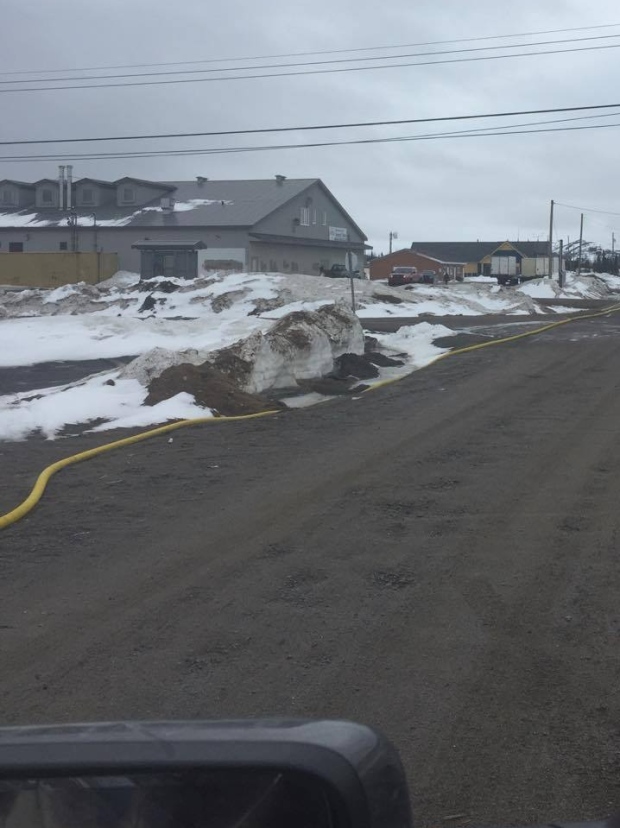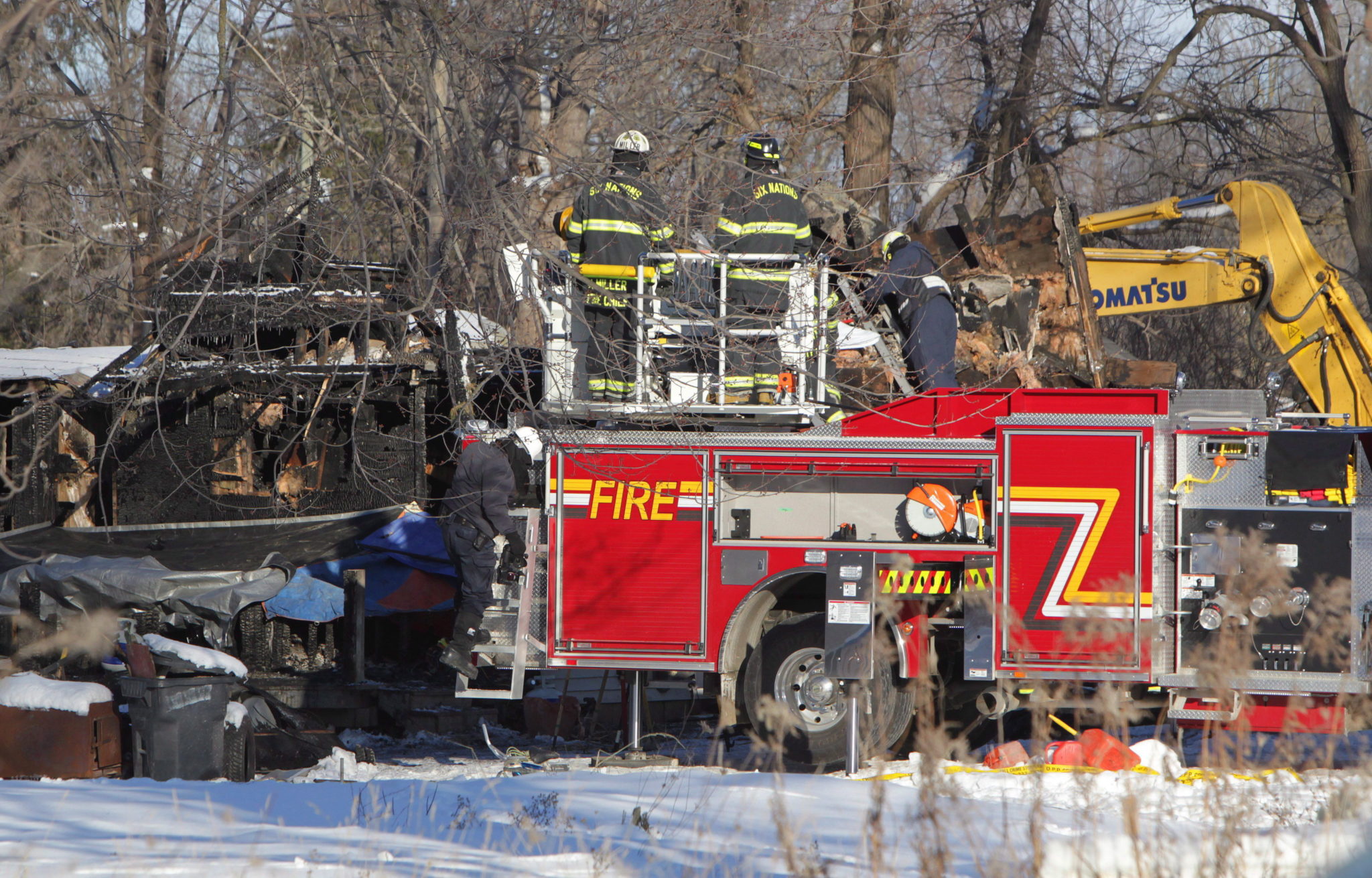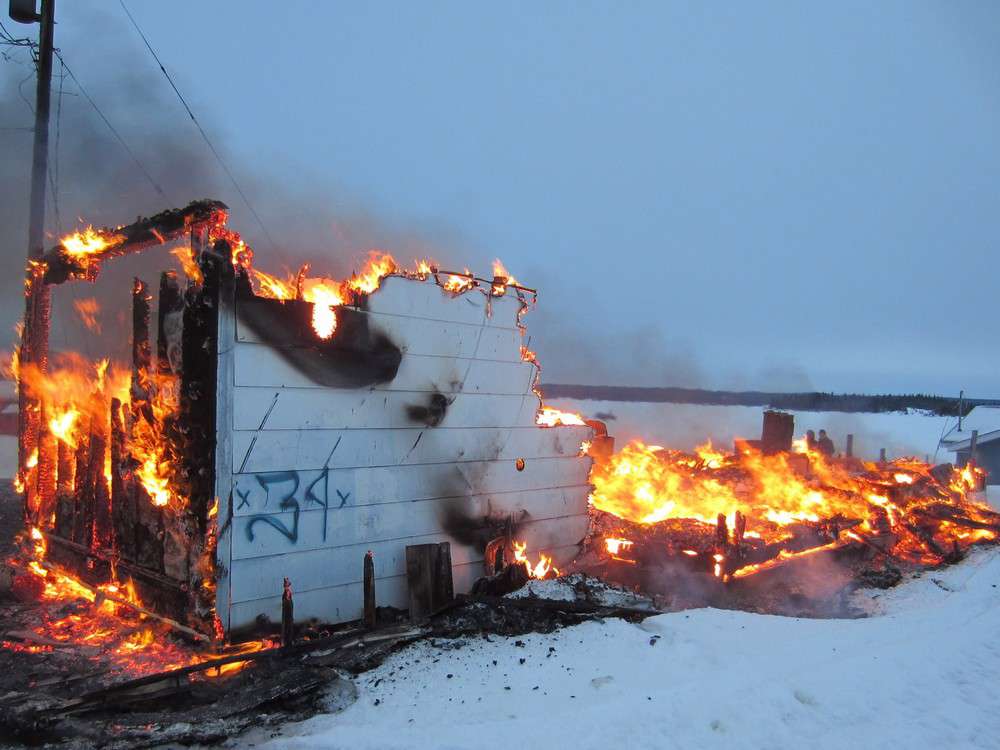Before dawn on May 8 in the Mushuau Innu First Nation on the chilly Labrador coast, an abandoned house caught fire with a group of children inside, severely burning 11-year-old Coda and 17-year-old Jeremiah.Jeremiah pulled Coda out of the house, saving his life. Both boys were airlifted to hospital and survived.Two residents who were on the scene as flames consumed the house told VICE News the nearest fire hydrant across the street was not working at the time, so firefighters had to run a hose down to a hydrant on the next street. Indigenous Affairs disputes that account.“The fire hydrant outside the house that burned was working and this was verified by the Natuashish RCMP at the time of the fire on May 8, 2017,” a department spokesperson told VICE News in an email.The Natuashish RCMP, however, were not able to say whether the hydrant was working or not, saying only that the band council would have the most accurate information. Band manager Nick Paradisis was one of those on the scene who said the hydrant wasn’t working at the time of the fire.But the hydrant wasn’t the only problem. Government documents obtained by VICE News show Indigenous Affairs was aware two month before the fire that numerous fire safety recommendations had not been carried out, “posing significant risk to the community.”Across the country, Indigenous first responders say there are no fire laws or regulations on reserve, meaning there is no mandate to investigate fires, so the causes of house fires largely remain anecdotal. That’s a stark difference to off-reserve communities, which enjoy provincial fire regulations.Meeting minutes from Feb. 10 between regional government officials and community leaders state that consulting company Fire Rescue Atlantic carried out a fire protection assessment in June 2015 in Natuashish that found problems with training, maintenance, equipment, and safety education of community members.Indigenous Affairs knew there was an issue with fire safety on the reserve, but it took a number of escalating events, including the May 8 fire and the burning of an RCMP vehicle, for the department to make an inspection of fire infrastructure a priority, a source in the department told VICE News on the condition of anonymity.Although an emergency management plan was underway, the May 8 fire “expedited” the department’s inspection of the community’s fire equipment, band manager Nick Paradisis told VICE News.Today, Coda and Jeremiah have fully recovered, and the band manager says the fire hydrants are all working now. But fires like this one happen regularly in First Nations across the country, often with deadly consequences.
Indigenous Affairs disputes that account.“The fire hydrant outside the house that burned was working and this was verified by the Natuashish RCMP at the time of the fire on May 8, 2017,” a department spokesperson told VICE News in an email.The Natuashish RCMP, however, were not able to say whether the hydrant was working or not, saying only that the band council would have the most accurate information. Band manager Nick Paradisis was one of those on the scene who said the hydrant wasn’t working at the time of the fire.But the hydrant wasn’t the only problem. Government documents obtained by VICE News show Indigenous Affairs was aware two month before the fire that numerous fire safety recommendations had not been carried out, “posing significant risk to the community.”Across the country, Indigenous first responders say there are no fire laws or regulations on reserve, meaning there is no mandate to investigate fires, so the causes of house fires largely remain anecdotal. That’s a stark difference to off-reserve communities, which enjoy provincial fire regulations.Meeting minutes from Feb. 10 between regional government officials and community leaders state that consulting company Fire Rescue Atlantic carried out a fire protection assessment in June 2015 in Natuashish that found problems with training, maintenance, equipment, and safety education of community members.Indigenous Affairs knew there was an issue with fire safety on the reserve, but it took a number of escalating events, including the May 8 fire and the burning of an RCMP vehicle, for the department to make an inspection of fire infrastructure a priority, a source in the department told VICE News on the condition of anonymity.Although an emergency management plan was underway, the May 8 fire “expedited” the department’s inspection of the community’s fire equipment, band manager Nick Paradisis told VICE News.Today, Coda and Jeremiah have fully recovered, and the band manager says the fire hydrants are all working now. But fires like this one happen regularly in First Nations across the country, often with deadly consequences. AFAC calls fire protection “a shared responsibility” between Indigenous Affairs and First Nations governments — with Indigenous Affairs providing the funding. But the department doesn’t fund every fire protection proposal it receives; out of the 82 proposals First Nations sent to the Atlantic regional department in the last five years, it funded 67.Indigenous Affairs is responsible for funding firefighting equipment, detection systems and prevention programs. Between 2013 and 2017, Indigenous Affairs says it has invested more than $3.5 million to install smoke detectors in homes. It also funds AFAC, and says it is committed to creating an Indigenous fire marshal’s office that would “provide support to Indigenous communities in their efforts to improve safety and protection of people, property and environment.” Such an office would also develop culturally-appropriate Indigenous fire services across Canada, and develop and manage a national incident data collection system. But there’s no clear timeline for when the office will be up and running.“We also welcome the call for national fire protection legislation to improve fire safety on reserves,” INAC says.In remote communities, mental illness and substance abuse can also contribute to fires. That’s what happened with the May fire in Natuashish.In the early hours of the morning on May 8, five young people were hanging out in an abandoned house, huffing gas, according to Jeremiah Rich, who was 17 at the time. Community leaders have called the phenomenon of kids huffing solvent fumes an “epidemic.”Coda, 11, was playing with a lighter, which ignited the gas, setting the boy on fire.While the other kids fled, Jeremiah hit Coda with his coat and hands to stifle the flames. As he tried to save Coda, Jeremiah’s own hoodie caught fire.
AFAC calls fire protection “a shared responsibility” between Indigenous Affairs and First Nations governments — with Indigenous Affairs providing the funding. But the department doesn’t fund every fire protection proposal it receives; out of the 82 proposals First Nations sent to the Atlantic regional department in the last five years, it funded 67.Indigenous Affairs is responsible for funding firefighting equipment, detection systems and prevention programs. Between 2013 and 2017, Indigenous Affairs says it has invested more than $3.5 million to install smoke detectors in homes. It also funds AFAC, and says it is committed to creating an Indigenous fire marshal’s office that would “provide support to Indigenous communities in their efforts to improve safety and protection of people, property and environment.” Such an office would also develop culturally-appropriate Indigenous fire services across Canada, and develop and manage a national incident data collection system. But there’s no clear timeline for when the office will be up and running.“We also welcome the call for national fire protection legislation to improve fire safety on reserves,” INAC says.In remote communities, mental illness and substance abuse can also contribute to fires. That’s what happened with the May fire in Natuashish.In the early hours of the morning on May 8, five young people were hanging out in an abandoned house, huffing gas, according to Jeremiah Rich, who was 17 at the time. Community leaders have called the phenomenon of kids huffing solvent fumes an “epidemic.”Coda, 11, was playing with a lighter, which ignited the gas, setting the boy on fire.While the other kids fled, Jeremiah hit Coda with his coat and hands to stifle the flames. As he tried to save Coda, Jeremiah’s own hoodie caught fire. He took off his hoodie and pants to escape the flames, and pulled Coda out of the house to safety. There, he waited with the badly burned boy for help to arrive.Volunteer firefighters arrived on the scene about 20 minutes later, Jeremiah said.Suffering severe burns, the boys were airlifted to hospital — Jeremiah to St. John’s and Coda to a burn unit in Toronto.Band manager Nick Paradisis, who has lived in the community for about a year, was just across the street at the time of the fire.“The fire hydrant right outside the house was not working at the time,” he told VICE News over the phone. “The firemen had to hook up the hose maybe 50 metres from that one.”The fire had already severely burned the house by the time the firefighters arrived, and it didn’t take much time to hook up the hose, so even if the hydrant across the street had been working, it would not have saved the structure, Paradisis said.The fire created a sense of urgency for Indigenous Affairs to conduct a community fire inspection.“INAC has always highlighted the issues with the fire hydrants,” Paradisis said. “It’s just that it has taken some time to get them inspected and properly checked.”According to the Feb. 10 government report obtained by VICE News, INAC knew the community had issues with its firefighting equipment and that residents were at risk.The report says the reason for the June 2015 inspection was reports of broken hydrants.“Recommendations of previous reports have not been implemented, posing significant risk to the community,” the Feb. 10 document states.“INAC and MIFN need to work together to ensure report recommendations are addressed and a plan is developed to ensure fire prevention and protection. A comprehensive emergency management plan, including fire protection and prevention is necessary to mitigate risks to the community members.”Grand Chief Gregory Rich said when he was chief, between 2013 and 2016, he was aware of 29 fire hydrants that were out of order.Following the May fire in Natuashish, the hydrants were all thoroughly tested and checked by inspectors from Indigenous Affairs, the band manager said.“That was taken care of immediately after the fire. …The fire hydrants are working perfectly well now.”According to the AFN, the problem with fire resource funding comes back to a two percent funding cap that has been lambasted by Indigenous groups.In 1996, Jean Chretien’s Liberal government imposed a two percent limit on funding increases for First Nations — a practice that has continued for 20 years. While populations on reserve are growing rapidly, federal funding has not kept pace.That means money for everything from housing, to water plants and fire protection is limited.Indigenous Affairs minister Carolyn Bennett says the government has lifted the two percent cap, but a ministerial briefing obtained by NDP critic Charlie Angus showed the 2016-17 budget had only a two percent increase over the previous year — the same funding model that has continued for two decades.The impact of this funding shortfall is hitting fire safety, critics say. More than 50 First Nations currently lack adequate resources to fight fires, according to a July 2016 briefing note obtained by CBC.There are also strict rules around government funding. Elaine Johnson, chief of Serpent River First Nation in Ontario, told VICE News her community had a surplus after building a new water treatment plant. She wanted to spend that money to install fire hydrants in a fire-prone area of the community, but Indigenous Affairs said that was against the rules. It was only by fundraising that the community was able to install hydrants in that area, she said.After the hydrants were eventually installed, the community had another major fire. The new hydrants helped them stop the spread of the fire to other buildings, she said.The Aboriginal Firefighters Association of Canada, which is funded by Indigenous Affairs, has been pushing since 1992 to reduce fire deaths on reserve.AFAC is focused first on increasing fire education on reserve — think: stop-drop-and-roll, and get-out stay-out. They also want more working smoke detectors in homes: “We know for certain that is a gap,” says AFAC executive director Blaine Wiggins.Instead of fire laws and regulations on reserve, AFAC wants to see fire safety standards accepted and enforced by band councils.
He took off his hoodie and pants to escape the flames, and pulled Coda out of the house to safety. There, he waited with the badly burned boy for help to arrive.Volunteer firefighters arrived on the scene about 20 minutes later, Jeremiah said.Suffering severe burns, the boys were airlifted to hospital — Jeremiah to St. John’s and Coda to a burn unit in Toronto.Band manager Nick Paradisis, who has lived in the community for about a year, was just across the street at the time of the fire.“The fire hydrant right outside the house was not working at the time,” he told VICE News over the phone. “The firemen had to hook up the hose maybe 50 metres from that one.”The fire had already severely burned the house by the time the firefighters arrived, and it didn’t take much time to hook up the hose, so even if the hydrant across the street had been working, it would not have saved the structure, Paradisis said.The fire created a sense of urgency for Indigenous Affairs to conduct a community fire inspection.“INAC has always highlighted the issues with the fire hydrants,” Paradisis said. “It’s just that it has taken some time to get them inspected and properly checked.”According to the Feb. 10 government report obtained by VICE News, INAC knew the community had issues with its firefighting equipment and that residents were at risk.The report says the reason for the June 2015 inspection was reports of broken hydrants.“Recommendations of previous reports have not been implemented, posing significant risk to the community,” the Feb. 10 document states.“INAC and MIFN need to work together to ensure report recommendations are addressed and a plan is developed to ensure fire prevention and protection. A comprehensive emergency management plan, including fire protection and prevention is necessary to mitigate risks to the community members.”Grand Chief Gregory Rich said when he was chief, between 2013 and 2016, he was aware of 29 fire hydrants that were out of order.Following the May fire in Natuashish, the hydrants were all thoroughly tested and checked by inspectors from Indigenous Affairs, the band manager said.“That was taken care of immediately after the fire. …The fire hydrants are working perfectly well now.”According to the AFN, the problem with fire resource funding comes back to a two percent funding cap that has been lambasted by Indigenous groups.In 1996, Jean Chretien’s Liberal government imposed a two percent limit on funding increases for First Nations — a practice that has continued for 20 years. While populations on reserve are growing rapidly, federal funding has not kept pace.That means money for everything from housing, to water plants and fire protection is limited.Indigenous Affairs minister Carolyn Bennett says the government has lifted the two percent cap, but a ministerial briefing obtained by NDP critic Charlie Angus showed the 2016-17 budget had only a two percent increase over the previous year — the same funding model that has continued for two decades.The impact of this funding shortfall is hitting fire safety, critics say. More than 50 First Nations currently lack adequate resources to fight fires, according to a July 2016 briefing note obtained by CBC.There are also strict rules around government funding. Elaine Johnson, chief of Serpent River First Nation in Ontario, told VICE News her community had a surplus after building a new water treatment plant. She wanted to spend that money to install fire hydrants in a fire-prone area of the community, but Indigenous Affairs said that was against the rules. It was only by fundraising that the community was able to install hydrants in that area, she said.After the hydrants were eventually installed, the community had another major fire. The new hydrants helped them stop the spread of the fire to other buildings, she said.The Aboriginal Firefighters Association of Canada, which is funded by Indigenous Affairs, has been pushing since 1992 to reduce fire deaths on reserve.AFAC is focused first on increasing fire education on reserve — think: stop-drop-and-roll, and get-out stay-out. They also want more working smoke detectors in homes: “We know for certain that is a gap,” says AFAC executive director Blaine Wiggins.Instead of fire laws and regulations on reserve, AFAC wants to see fire safety standards accepted and enforced by band councils. AFAC President Arnold Lazare Lazare believes the government’s commitment to an Indigenous fire marshal’s office — an idea that came out of AFAC community consultations — will “substantially” reduce fire deaths on reserve.Although fire safety experts still want fire standards for reserves, the situation in Natuashish has been largely solved.Paradisis told VICE News the inspection by Indigenous Affairs following the May fire found some issues with the community’s old fire truck, but it has now been fixed. A new fire truck is expected to arrive in the community any day.“We’re quite confident that we’re in a position now to meet any fire that breaks out,” he said.
AFAC President Arnold Lazare Lazare believes the government’s commitment to an Indigenous fire marshal’s office — an idea that came out of AFAC community consultations — will “substantially” reduce fire deaths on reserve.Although fire safety experts still want fire standards for reserves, the situation in Natuashish has been largely solved.Paradisis told VICE News the inspection by Indigenous Affairs following the May fire found some issues with the community’s old fire truck, but it has now been fixed. A new fire truck is expected to arrive in the community any day.“We’re quite confident that we’re in a position now to meet any fire that breaks out,” he said.
Advertisement

Advertisement
People on reserve die in house fires at a rate 10 times greater than those living off reserve, according to a 2007 Canadian Mortgage and Housing Corporation report. The report was based on data gathered by Indigenous Affairs. The department stopped collecting those numbers in 2010 — a year that saw 26 fire deaths on reserve.Since the early 1990s, the Assembly of First Nations (AFN) and the Aboriginal Firefighters Association of Canada (AFAC) have repeatedly raised concerns about what they call a rampant issue.Indigenous communities regularly rely on volunteer firefighters as first responders, though they often lack adequate training. It’s also rare to find working smoke detectors in many reserve homes, while it is common to see several families living in a single home together — a sometimes deadly combination.People on reserve die in house fires at a rate 10.4 times greater than those living off reserve

Advertisement
The fire in Natuashish
Advertisement

“Recommendations of previous reports have not been implemented, posing significant risk to the community”
Advertisement
A broader problem
Because there are no laws or regulations on reserve, there is no mandate to investigate fires, so the causes of house fires remain anecdotal.
Advertisement
Advertisement
